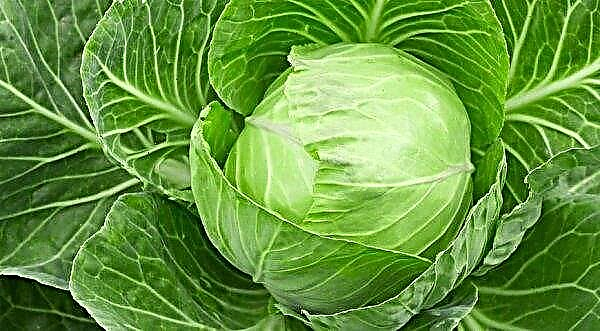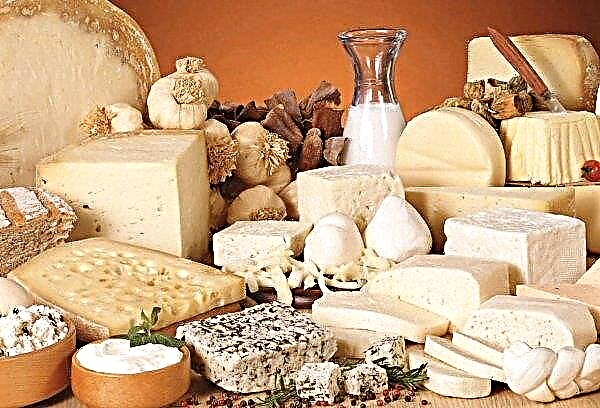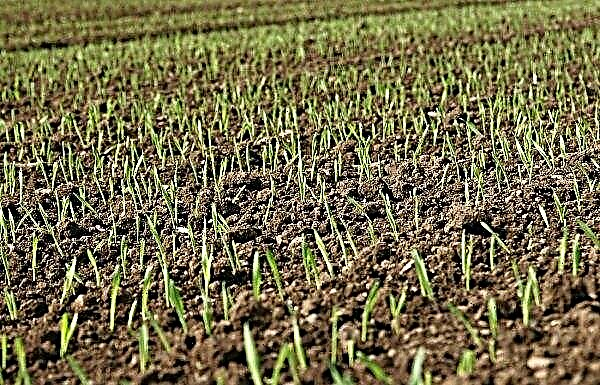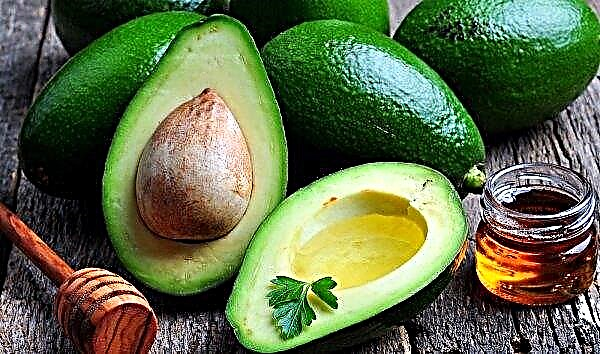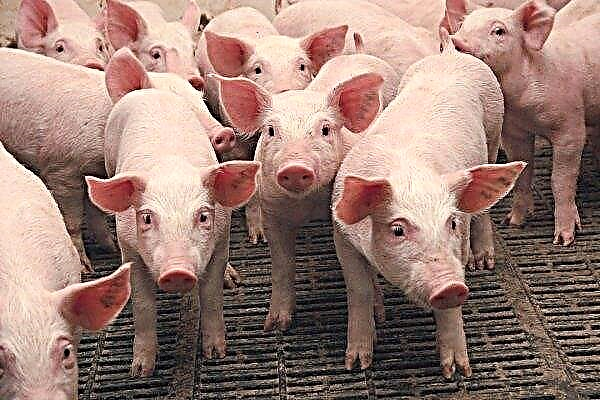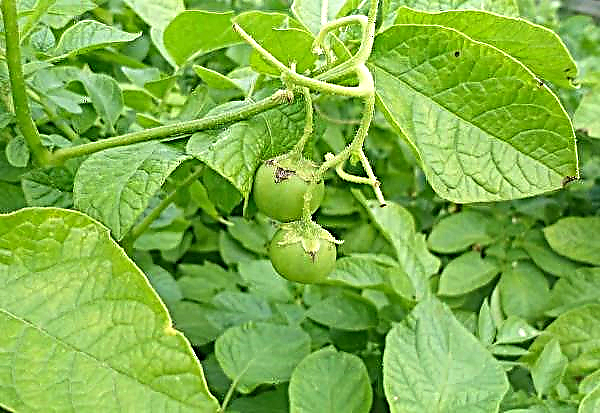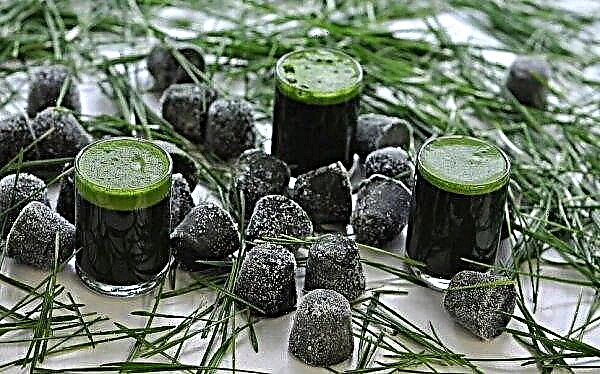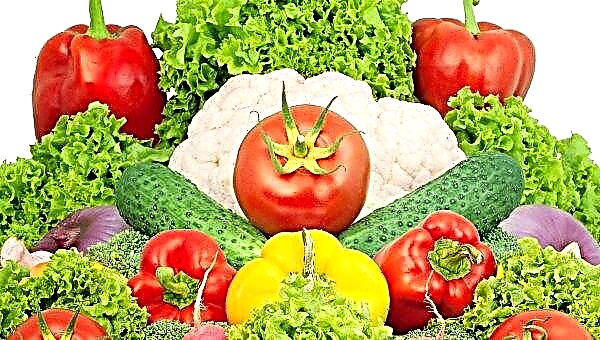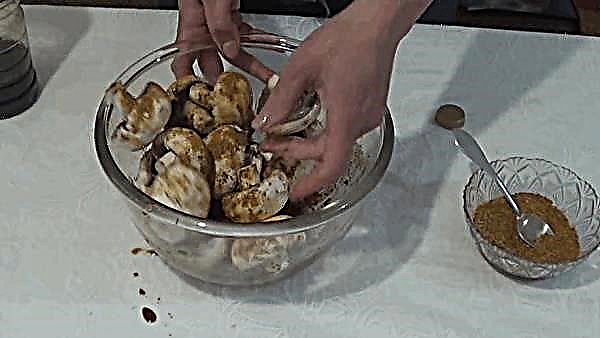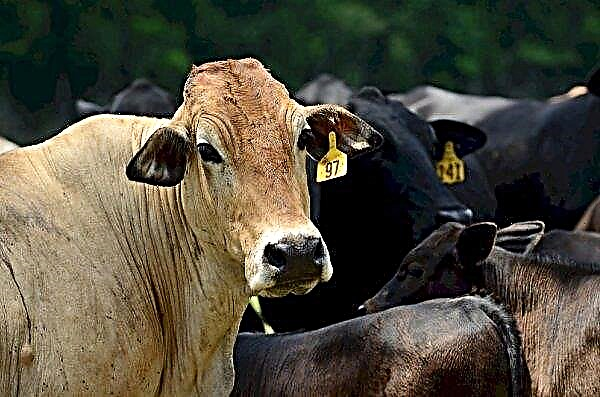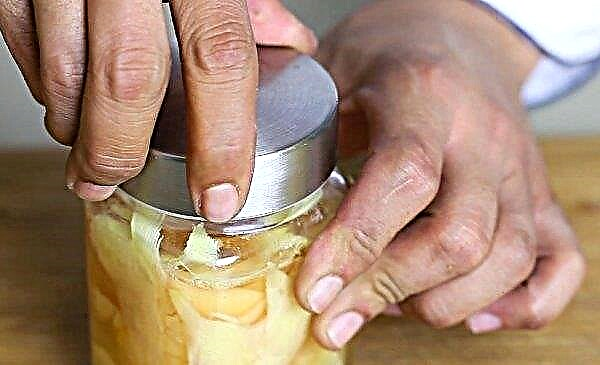Among crops, onion is the 6th largest in the world in terms of popularity, and even surpasses wheat in terms of the amount of territory on which it is grown. Today it is represented by more than 1200 varieties and many hybrid forms. Most of them are bred relatively recently, as is the Elan variety, which will be discussed in the review.
Description and characteristics of the variety
Variety Elan bred in the Kuban, so it is great for growing in a temperate and warm climate. It is characterized as superearly. This means that first of all you can get excellent greens “on the feather” in April or May. At this time, the onion receives the maximum amount of sun and moisture. If you do not need a large amount of greens, you will get a crop of excellent bulbs in early summer. Elan is also described as a winter onion - with a possible planting in November.
Did you know? The Latin name Allium was given to the bow by the famous botanist Carl Linnaeus. He took the Celtic word for burning — “All”, thereby characterizing its main quality.
In winter, bulbs are planted in order to get the crop early - in early June. With spring planting, the crop should be expected a month later. More precisely, the planting dates for the Elan cultivar are as follows: no later than a month before stable frosts in the fall, and no earlier than a month before the last soil frost in the spring. The growing season is 90 days. It is intended for cultivation on personal plots or on an industrial scale. It is considered universal and can be used both raw and in various dishes. The main characteristics of the variety Elan:
The main characteristics of the variety Elan:
- bulb weight - 120 g, diameter - 8 cm, size - medium;
- the maximum fixed bulb size is 15 cm with a weight of about 500 g;
- form - spherical or slightly flattened;
- the number of bulbs is one;
- pulp - white, aromatic;
- taste - spicy, sweetish;
- scales - straw-yellow, tight-fitting to the bulb;
- rosette of leaves is rather thick;
- height - up to 30 cm;
- during the growth period, the greens stand directly and practically do not lie down;
- leaf color - dark green with a waxy coating;
- sheet diameter - medium.
Did you know? Distinctive feature of a grade Elan — does not cause tears when slicing.
It is characterized by good germination of seeds (80–90%). Resistant to most bulb diseases. It is very hardy and can grow in a variety of growing conditions.
Advantages and disadvantages
- The advantages of the variety are the following features:
- early ripening;
- bulb uniformity;
- moderate bitterness;
- good taste.
Among the shortcomings, farmers note a low keeping quality: Elan cannot be stored all winter and begins to dry out and lose its properties. But if you take care of the correct microclimate for storage, then this drawback is not significant.
Growing at home
Onions are perennials, therefore, propagated by seeds and seeds - small bulbs of the first year of growth. In household plots, sowing is usually practiced. To grow onions requires a sunny, well-ventilated open area. The soil must be loose, otherwise the plant forms small bulbs and may be affected by powdery mildew. When growing, crop rotation is observed, planting it after cabbage, solanaceous (tomato, pepper), potatoes or cucumbers. Crop rotation allows to reduce crop damage by pests that will continue to exist on the site after harvesting.
Did you know? The ancient Egyptians considered the spherical bulb a symbol of the universe.
For an accelerated harvest, cultivation from seedlings is used, followed by its placement in open ground. Seedling method is not practiced by summer residents, as it is considered labor-intensive. But if you grow onions for sale, then an accelerated harvest will be a significant advantage. This will ensure the ripening of the crop 2 weeks earlier than during normal planting. Elan is easy enough to grow and not too susceptible to disease. Onions like cool weather. This helps him to take root and grow better. Most often, its landing is carried out in the spring. But in regions with mild winters, winter landing is practiced. Onions grow well in cold weather, take root and form leaves, and in warm weather form bulbs. Onion seeds in the ground in the spring planted about a month before the end of the frost. If indoors on seedlings, then 2-3 weeks earlier. When the feather reaches a height of 6–9 cm, seedlings can begin to be hardened, and after a week planted in the ground. Outdoors, planting is carried out in rows with a distance of 7 cm between rows and 5 cm between plants.
But in regions with mild winters, winter landing is practiced. Onions grow well in cold weather, take root and form leaves, and in warm weather form bulbs. Onion seeds in the ground in the spring planted about a month before the end of the frost. If indoors on seedlings, then 2-3 weeks earlier. When the feather reaches a height of 6–9 cm, seedlings can begin to be hardened, and after a week planted in the ground. Outdoors, planting is carried out in rows with a distance of 7 cm between rows and 5 cm between plants.
Optimum seeding time
Sowing onions from seeds is practiced in early spring. It is enough that the soil warms up to + 1 ° C. Typically, planting is carried out in March-April 4-6 weeks before the last freeze. Onions are long daylight crops and need 14–16 hours of daylight to form bulbs. It is not recommended to plant onions in June, as high temperatures also negatively affect bulb formation.
Winter sowing is carried out in November or December for harvesting from late spring to early summer. A prerequisite is planting in normal, not frozen soil 3 weeks before the start of stable frosts with a temperature of –2 ° С.
Growing conditions
Onion seeds have a hard shell and at +1 ... + 3 ° C germinate very slowly. It is much better if the air temperature reaches +15 ... + 19 ° С. They also take into account that onions are frost-resistant and feel good with a prolonged decrease in temperature to –4 ° С and a short one to –7 ° С. At temperatures below + 12 ° C, the root system develops well, and if it rises, then leaves develop intensely. If onions are grown on herbs, then the temperature should be at the level of +20 ... + 25 ° С.
The culture is not very demanding on light, so cultivation is permissible in the area brightly lit by the sun, and in the area with partial shading. The plant has increased moisture requirements due to the small root system. In the first half of the growing season there must be a lot of water and moderate lighting, and in the second half, on the contrary - a lot of sun. A lack of moisture during this period positively affects the quality of the bulbs.
Did you know? Over the centuries, healing properties have been attributed to onions. It is used in traditional medicine to treat various diseases, such as colds, earaches, laryngitis, animal bites, burns and warts.
Soil and fertilizer
For the cultivation of the Elan variety, as well as for other varieties, it is necessary to prepare a site with nutrient soil. The soil acidity on the site should not be more than 7 pH. In areas with a high clay content, the soil is more acidic, therefore, lime or dolomite flour is added there 1-2 weeks before planting. You can measure the level of acidity with a special device or test strips, which are sold in stores for gardeners. Dense soil prevents the outflow of moisture after irrigation or rain, creating favorable conditions for the development of putrefactive bacteria. To avoid this, use an inclined area that provides a natural outflow of water, and dilute the soil in the bed with sand and peat. Add 2-6 kg / m² of humus to the site when planting. Add any phosphate-potassium fertilizer. You can create a layered structure in the planting trench: by placing fertilizers, then a small layer of soil, and then planting onions and adding more soil to the soil.
Dense soil prevents the outflow of moisture after irrigation or rain, creating favorable conditions for the development of putrefactive bacteria. To avoid this, use an inclined area that provides a natural outflow of water, and dilute the soil in the bed with sand and peat. Add 2-6 kg / m² of humus to the site when planting. Add any phosphate-potassium fertilizer. You can create a layered structure in the planting trench: by placing fertilizers, then a small layer of soil, and then planting onions and adding more soil to the soil.
Important! The bulb grows better and gains weight, if part of it — the neck and shoulders are located above the surface of the bed.
Cultivation methods
In an annual culture, onions are grown by:
- sowing seeds in spring in open ground;
- planting onion sets in the ground to obtain marketable onions - the method is also called vegetative propagation;
- seedling method of growing.
In open ground, seeds are usually planted in spring. A bed for sowing is prepared in the fall, digging the soil and deoxidizing it. In spring, they form landing trenches, fertilize and plant bulbs or seeds. Winter winters have no outstanding advantages, but are practiced by some farmers. Seedling method is necessary in regions with a short summer to accelerate crop growth. Also, some farmers argue that with the seedling method, the bulbs are formed larger, and their taste becomes softer. Vegetative propagation or sowing onion sets technologically almost no different from planting seeds. It is carried out in May.
Seedling method is necessary in regions with a short summer to accelerate crop growth. Also, some farmers argue that with the seedling method, the bulbs are formed larger, and their taste becomes softer. Vegetative propagation or sowing onion sets technologically almost no different from planting seeds. It is carried out in May.
Landing technology is:
- soil preparation;
- seed disinfection and preparation;
- preparing for landing.
Seed cultivation
Sowing seeds is carried out between rows. The site is dug up, grooves are formed with a distance between them - from 7 to 20 cm. Organic or mineral fertilizers are applied to the bottom of the grooves. Using rotted manure as a fertilizer has an additional advantage - its layer serves as an additional source of heating, which is good if planting is carried out in early March.
The seeding rate of Chernushka is 1.5 g / m². Depth of embedding is 2 cm. Previously, the seeds are moistened and germinated. This process accelerates the emergence of seedlings, makes them more uniform and increases productivity.
Vegetative method (sevka method)
The vegetative method is the cultivation of onions from the set. For cultivation, the smallest onions are selected with a diameter of up to 2 cm. Large ones are used for growing feathers. And there is an explanation for this - bulbs with a diameter of more than 2 cm shoot very strongly. The arrow is a peduncle that is formed ahead of schedule. Such onions form small bulbs, and they are very poorly stored. Sowing can begin in October for early varieties. This will allow the bulbs to take root, winter and crop well by the first decade of June. Spring sowing sowing will yield a month later. Landing is carried out in rows. The distance between neighboring ones is 12–15 cm. The minimum permissible distance is 7.5 cm. The seeding rate is 6–8 g / m² without thinning.
Sowing can begin in October for early varieties. This will allow the bulbs to take root, winter and crop well by the first decade of June. Spring sowing sowing will yield a month later. Landing is carried out in rows. The distance between neighboring ones is 12–15 cm. The minimum permissible distance is 7.5 cm. The seeding rate is 6–8 g / m² without thinning.
Important! It is believed that onions grown in warm climates have a milder flavor than in other climatic zones.
Variety Care Features
Crop care consists of:
- loosening the soil;
- weed removal;
- glaze.
If fertilizers are applied during planting, then the onion will be able to do without additional fertilizer application. But since fertilizers increase productivity by 30%, and also allow you to get large, uniform bulbs, fertilizing is carried out in an amount from 2 for early varieties to 5-6 times per season for onions of late ripening varieties.
Watering and feeding
A small root system requires frequent watering, especially in the first month of growth.
When watering, take into account the following:
- watered only when the soil becomes dry;
- pour water directly in the zone of the root system - 5 cm more than the size of the bulb;
- watering speed should be small so as not to damage the micro roots;
- do not pour water between rows on empty areas, so as not to create conditions for weed growth;
- Use row spacing as a humidity regulator on the beds.
It is advisable to water the crops with water at or near room temperature. Cold water is a source of stress. But since the water heating system for irrigation is usually not installed, then consider installing the drip irrigation system. Water is supplied to the bulb with a special dispenser. A low watering rate is preferred for a weak onion root system.
At the same time, the soil is not compacted into lumps, you save water and spend it more rationally. Watering is carried out as the soil dries, but at least 1 time per week. During the growing season, you will spend about 9-10 watering. During growth, onions are fed 2-3 times. The first top dressing is carried out if the plants have reached a height of 2-3 cm, and the second - 20-25 days after the first. When using organic fertilizers, the following dosages are adhered to:
When using organic fertilizers, the following dosages are adhered to:
- mullein or rotted manure is bred in water in a ratio of 1:10;
- bird droppings are diluted in a ratio of 1:15.
If mineral fertilizers are used, then dissolved in 10 l of water:
- 25-30 g of superphosphate;
- 10-15 g of ammonium nitrate;
- 10-15 g of potassium chloride.
Soil loosening
At the time of planting, the soil on the bed is quite loose. After watering, it condenses and a dense crust forms on top, which does not pass oxygen to the roots. If it rains, then dense soil retains moisture in the bulb, increasing the likelihood of phytopathogens. To prevent this, the soil is regularly loosened the next day after moistening the soil. Use a garden hoe or other tool. His movement should be directed from the bow to the side. So you make room for the further development of the bulb.
Use a garden hoe or other tool. His movement should be directed from the bow to the side. So you make room for the further development of the bulb.
Weeding
Weeds grow almost everywhere, and onion beds are no exception. If you often do not want to sow the soil, then cover the aisles with mulching material. It can be materials of organic origin — straw, sawdust, leaves, or materials of inorganic origin — spanbond, plastic film, and others.
Their tasks include:
- retain moisture in the soil after watering;
- prevent weed growth;
- reduce the number of pests in contact with plants.

Pest and Disease Control
With excessive moisture, soil fungi develop. Onion rot can cause leaf wilting, root rot, softening of the bulb. Depending on the type of rot, the plant becomes covered with plaque, necrotic spots and dies. It is important to avoid waterlogging of the soil by organizing proper watering and good drainage. To avoid problems, treat the plants with a solution of copper sulfate (2 g), urea (10 g) and zinc (1 g) dissolved in 10 l of water, because it is much easier to avoid the disease than to treat.
Powdery mildew is also a fungal disease that damages foliage and bulbs, resulting in lower yields. It manifests itself in the form of a soft gray coating, brown spots on the leaves. It also occurs due to increased humidity. Make sure that there is always enough light and air around the plants. Do not thicken plantings and regularly remove weeds. Avoid getting water on the bulbs when watering. Remove infected leaves. A good way to deal with this is to spray the plantation with a 1% solution of Bordeaux fluid or a solution of sulfur (50 g per 10 liters of water).Important! Fungi are transferred using water during irrigation, tillage tools and even shoes, so use all available preventative measures to prevent the onset of infection.
 Another onion disease is onion rust.It affects onions grown on herbs. The fungus appears in the form of small rusty spots on the leaves, which is bad for the presentation of the plant. The phytopathogen that causes the problem hibernates on plant organics, so the main preventive measure is the removal of any tops after harvesting from the site. The development of the disease contributes to cool and damp weather. To combat fungi, fungicides “Topaz”, “Falcon”, “Ordan” are used according to the instructions on the package.
Another onion disease is onion rust.It affects onions grown on herbs. The fungus appears in the form of small rusty spots on the leaves, which is bad for the presentation of the plant. The phytopathogen that causes the problem hibernates on plant organics, so the main preventive measure is the removal of any tops after harvesting from the site. The development of the disease contributes to cool and damp weather. To combat fungi, fungicides “Topaz”, “Falcon”, “Ordan” are used according to the instructions on the package.If the crop was collected from the site infected with the fungus, then before laying it for storage, the bulbs are treated with hot water or heat at a temperature of + 40 ° C for several hours. This helps destroy spores of fungi. Bordeaux liquid is also used to process crops. It is recommended that she cultivate the soil for disinfection after harvesting. As for pests, most often we are talking about insects that live in the ground and affect the bulb. It can be the larvae of various beetles and nematodes.
Did you know? The name "onion" received for the similarity of its shape with turnips.
The main pests:
- Onion fly dangerous in that its breeding place is onions. The insect lays larvae in the leaves. Hatching, they begin to develop in the neck of the bulb, stopping growth and development, and then destroying the plant. The main signs of infection: yellowed leaves, a sharp putrid smell, intensifying after watering. For development, the larvae will need only 17 days to become a new generation of flies. Plants affected by insects will have to be destroyed. Processing the location of the infected bulb with boiling water is also practiced. The mulching material helps fight the pest, as the fly simply does not get the opportunity to lay eggs. Sprinkling the beds with a layer of ash is also a good preventive measure.

- Thrips - sucking insects that feed on plant sap. Their presence is noticeable by small silver spots on the leaf plate. They are dangerous because in places where the leaf plate is damaged, spores of fungi can develop. To destroy pests use the processing of crops with a solution of insecticidal soap.
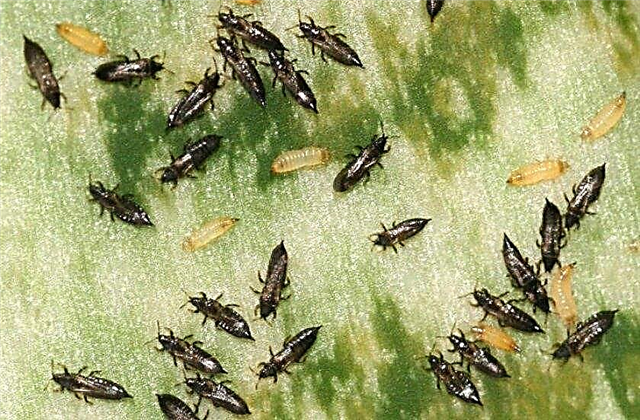
- Bulbs are also affected by small worms - nematodes. They feed on the sap of the plant, damage the bulb or leaves. The affected plant stops growth, the bulbs soften, and the leaf plates begin to deform. To combat the nematode, it is recommended to follow crop rotation rules and process beds and seeds with hot water.
Harvesting and storing onions
Onion ripening time depends not so much on the variety as on the planting time and prevailing weather. Take into account the duration of the vegetation of the Elan variety - 90 days. By the end of this period, onion tops should begin to turn yellow. If it rains, then this will not happen. To speed up the process, the onions are slightly lifted by the tops. Rupture of the roots will lead to a fade in the development of the bulb.
Onions with drying tops are not watered and left in the ground for 2-3 weeks in order to allow the scales to condense. Then remove the bulbs from the soil and transfer to a dry room for further drying. Dry tops and roots are carefully cut. A small tail 2-3 cm long is left on top. The room temperature should be around +20 ... + 30 ° С. Prepared onions are stored in boxes. For long-term storage, select only those bulbs that do not have external damage. To preserve the harvest longer, it is practiced to disinfect the room in which it will be stored with a 10% solution of freshly slaked lime. Bulb storage temperature - + 14 ° С, relative humidity - 70–80%. With the onset of frost, onions are covered with straw or hay.
For long-term storage, select only those bulbs that do not have external damage. To preserve the harvest longer, it is practiced to disinfect the room in which it will be stored with a 10% solution of freshly slaked lime. Bulb storage temperature - + 14 ° С, relative humidity - 70–80%. With the onset of frost, onions are covered with straw or hay.
Important! Onion sets are stored in a warm room at a temperature of +18...+20°C and relative humidity — 65–70% If in winter there are temperature fluctuations, then store the set at a temperature of +1°C is impossible. When landing, he will leave the arrow.
Useful recommendations from gardeners
Onions grow well on most soils and in any conditions. But they still affect the yield, so experienced gardeners have long developed a number of additional rules that should be followed:
- use only fresh seeds for planting. The longer they are stored, the lower the percentage of germination;
- fresh seeds are less contaminated with pathogens, but treat them before planting with prophylaxis to prevent fungicides;
- growth stimulants allow you to get a simultaneous ripening of the crop and approximately the same size bulbs, while they are not toxic to humans and are applicable to any varieties of onions;
- in warm weather, seeds germinate better: at a temperature of +16 ... + 18 ° C, sprouts will appear in a week, and at lower temperatures - only after 2-3. Consider this when determining the timing of landing;
- the root system of the onion is very small, therefore feed only in the root zone and do not water the soil deeper than 3-5 cm, so as not to wash the fertilizers into the lower layers of the soil;
- weed removal it is especially important at the first stage of plant development - a small bulb simply will not be able to compete with weeds for moisture and nutrition;
- use mulchingto protect crops from weeds;
- do not water the aisles, onion roots are not there, but there may be weed seeds;
- do not water onions 2-3 weeks before harvest, this will help to get more light bulbs that will be stored longer.
 Now you know exactly what to do to get a large crop of onions on your site. Use the acquired knowledge in practice and enjoy the result. And remember that a good harvest is not only the conditions that you provide, but also a good planting material.
Now you know exactly what to do to get a large crop of onions on your site. Use the acquired knowledge in practice and enjoy the result. And remember that a good harvest is not only the conditions that you provide, but also a good planting material.



